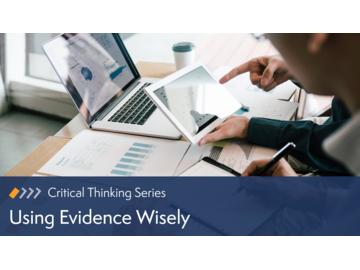Critical Thinking Series
Keywords: critical thinking, Problem-solving, decision making, leadership
Related Courses

Critical Thinking: Making the Case for Critical Thinking
Visited 897 times
$5.95

Critical Thinking: Being an Agile Critical Thinker
Visited 1,017 times
$5.95
Critical Thinking Series

- What is an argument?
- Determine whether there is sufficient, valid support for the argument
- Ensure arguments are relevant to the problem

Critical thinking is a method of achieving the best solution to a problem. It provides you with a bigger picture and more information on which to base your decisions. By digging deeper and being more aware of poor decision-making practices, you can eliminate faulty habits and facilitate beneficial action within your organization.
Objectives:
- What is critical thinking?
- Identify the benefits of using critical thinking in your personal and professional lives
- Spot habits of non-critical thinking that you might already be using
Course Features: Audio Narration;Video;Job Aids and Reference Materials

Practicing agile critical thinking can improve your relationships and the outcomes of your decisions. Learn the steps of critical thinking and become more aware of your current thinking patterns that could be improved by this method. With an open mind and a curiosity to learn, you can advance your teamwork and performance.
Objectives:
- What is an agile critical thinker and what does critical thinking require?
- Adopt the attitude, knowledge, and skill necessary to reach the best conclusions.
- Identify problems where you can apply the steps of critical thinking
Course Features: Audio Narration;Video;Job Aids and Reference Materials

Assumptions are so engrained in our automatic thinking, we usually don’t realize we’re making them. By consciously and actively identifying and challenging assumptions, you can eliminate the biases and stereotypes that get in the way of critical thinking. Recognizing your assumptions helps deconstruct the problem so you can find the most appropriate solution.
Objectives:
- Identify the three most common biases that cause assumptions
- Challenge assumptions and mental shortcuts that cloud reasoning
- Recognize the difference between correct and incorrect assumptions
Course Features: Audio Narration;Video;Job Aids and Reference Materials

Asking questions is crucial to the success of each stage of the critical thinking process. It enables you to find errors in your existing knowledge and gain insights that will shape your solutions. While you’ll probably need to ask a lot of questions, quality is more important than quantity. Learn to work with your team to seek and acquire the answers that will bring you closer to the most beneficial conclusion.
Objectives:
- Ask the right questions with the right approach
- Apply the Socratic Method in your approach to the problem
- Bring your team into the critical thinking process
Course Features: Audio Narration, Video, Job Aids and Reference Materials

In the critical thinking process, every perspective is valuable because every perspective provides a different view of the issue being solved. The more unique perspectives you have, the more whole your picture of the problem will be, allowing you to reach the most fitting solution. Bringing in multiple perspectives will also help you to create and improve relationships and experiences within your organization.
Objectives:
- Gain insights from others who don’t share your perspective
- Build trust and relationships by keeping an open mind
- Get a big-picture look at the problem you’re working to solve
Course Features: Audio Narration, Video, Job Aids and Reference Materials

Arguments are supported by evidence, but not all evidence is relevant, factual, and valuable. Solving a problem with critical thinking requires careful analysis of the evidence to determine if and how the evidence should be used to help you reach a solution. Once you’ve identified the qualified evidence, you can determine whether there is enough valid support for the arguments that will influence your decisions.
Objectives:
- Distinguish between facts, opinions, and projections
- Determine whether your evidence is factual and relevant
- Ask questions to determine the value of your evidence
Course Features: Audio Narration, Video, Job Aids and Reference Materials

Throughout the critical thinking process, you’ll be dealing with a high volume of information. In order to use that information properly to reach the best possible solution, you’ll need to keep it organized and accessible. There are many topics available today for sorting, storing, and sharing information, but not all tools will be suitable for your specific situation. Evaluate the tools that are available and the tools that are already in use in your organization to identify what’s best for this particular problem.
Objectives:
- Use tools to manage, analyze, and synthesize information
- Identify what tools are suitable and available for your application
- Keep your information organized and accessible
Course Features: Audio Narration, Video, Job Aids and Reference Materials

- Overcome analysis paralysis and imposter syndrome
- Reflect honestly on your concerns
- Adhere to your deadline and learn from your decisions

The work you’ve done to take in and synthesize data, information, and arguments has gotten you to the point of drawing conclusions. In this course we explore how to analyze the information we have collected and come to meaningful conclusions.
Objectives:
- Recognize the consequences of action AND inaction
- Weigh the implications and risks
- Recognize tools that are helpful to sort through the data collected
Course Features: Audio Narration, Video, Job Aids and Reference Materials

Buy This Course
Price :
$59.95 ( Per License )
Resold modules appear on your website. You earn syndication share from each purchase. Contact Coggno to learn more on how to embed your own Portable Webshop in your website.